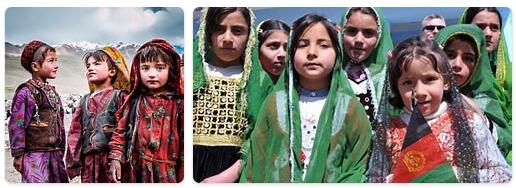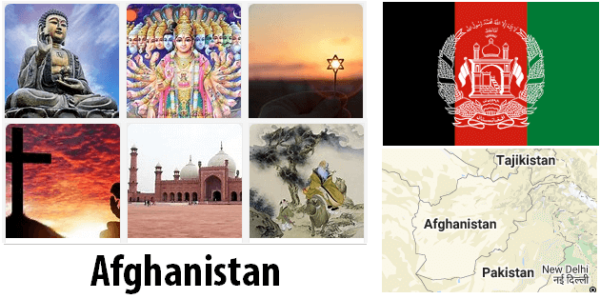Population
All information regarding the country’s population is very uncertain. The last population count was 1979, and after that the country has been in civil war.
The population increase is rapid and 44 percent of the population is estimated to be under 15 years. The country is most densely populated in the provinces around the capital Kabul. Other concentrations are found mainly in the Herat area in the northwest and in the Kunduz Valley in the north. The resident rural population usually lives in smaller villages adjacent to rivers and irrigated areas. Urbanization in Afghanistan is modest, and in 2019, 25 percent lived in cities. In addition to the capital Kabul (4 million residents in 2018), the three largest cities are Herat (506,900), Qandahar (461,900) and Mazar-e Sharif (427,600).
The population is divided into about 10 larger and more than 30 smaller ethnic groups. Although all residents of Afghanistan are officially called Afghans, this is actually the term for members of Afghanistan’s largest ethnic group, the Pashtuns, which comprise nearly half of the country’s population. The Pashtuns are mainly settled in the western, southern and eastern parts of Afghanistan and are divided into tribal durrani (west) and ghilzay (south and east) as well as a number of smaller tribes in the east (including afridi, mohmand, shinwari, waziri). Common to all pashtuns is the language, pashto, and the cultural norms, pashtunwali, which define the rules for the proper conduct of people in between.
The second largest group, the Tajiks, speak Persian (dari) and make up about one third of the population. They are found scattered throughout Afghanistan, for example around Herat and in the northeast. In Pashtun-dominated areas, the word Tajik is also often used as a general term for non-Pashtuns. In northern Afghanistan, a number of Mongolian people speak Turkish languages; the most important are the uz cup (2.9 million) and Turkmen (500,000); At the far northeast is a smaller group of Kyrgyz. In the north there are also scattered groups of so-called Arabs (about 70,000), who, however, speak Persian. In the central parts of Afghanistan there are Hazars (about 3 million), a Mongolian who speaks Persian and is Shiite (while most other groups are Sunnis); The Hazars are despised by many other groups. In the west there are Persian speakers, semi-nomadic and partly resident aimak (1.2 million). Baluchs (500,000) and the small, Dravidian-speaking Brahui group (200,000) live in the southernmost and westernmost regions. In the Hindu Coast Mountains in the east there are Nuristans (formerly Kafirs, 125,000-300,000) and Pashai (375,000), which are divided into tribes and speak languages of Indian origin.
According to thesciencetutor, a large number of Afghans are in consequence of the civil war in recent decades and political instability in exile. The largest refugee groups have been found for a few decades in Pakistan (1.7 million) and Iran (over 900,000, 2009). In addition, Afghan refugees now reside in most western countries, including Sweden.

Language
The official languages are Pashto and Dari, a local form of Persian. Both belong to the Iranian branch of the Indo-European languages and are written in Arabic. Estimates of the number of speakers vary, and it is not clear which of the languages is the largest, but together with other Persian varieties they are expected to be spoken by a total of 70-80%. Uzbek and Turkmen, both of whom are Turkish, speak a total of 6-10%. In addition, some 30 other Iranian and Indo-native languages are spoken as well as the Dravidian language brahui.
Religion
After a coalition of ten Islamic guerrilla groups (mujahidin) took power in April 1992, Afghanistan was proclaimed an Islamic state. However, a stricter Islamic regime was introduced with the Taliban’s seizure of power in September 1996. In October 1997, Afghanistan was declared an Islamic emirate, but the Taliban regime was not recognized internationally and the state of affairs was long unclear.
Islam gradually replaced other religions, mainly Buddhism and Zoroastrianism, from the first Arab conquest in 652 to the empire of the ghaznaids in the 11th century. However, the cafes in eastern Afghanistan were converted as late as the late 19th century. Today, 80% of Afghans are estimated to be Sunni Muslims, traditionally by the Hanafite law school. About 20% are Shia Muslims, of whom 18% are Imamites (the twelve-Imam sect) and just under 2% Ismailites. It can be difficult to draw a boundary between Sunnis and Shiites, as the latter in some cases resort to the dominant form of religion, so-called taqiya.
Sunnism appears in Afghanistan in a strictly traditional form. It emphasizes, inter alia, the importance of segregation between men and women outside the family. Among the Sunnis, the Sufis and their leaders (pir) traditionally had great influence. The piers usually belong to one of the great Sufis (Naqshbandi, Qadiri, Chishti or Suhravardi). Traditional folk Sufism is characterized by notions of magical healing and pilgrimage to the graves of holy men. The Shiites belonging to the twelve-Imam sect are found mainly in western and southwestern Afghanistan (where they are often called Farsiwan), among the central highland hazards, among the Tajiks in the northeastern mountain areas, among the Persian-speaking qizilbash in the Kabul region and some Pashtunese tribes on the border. Pakistan (especially turi and bangash). The Ismailites live mainly in the Bamiyan area in the central highlands and in the mountain province of Badakshan in the northeast. In the cities there are also smaller groups of Hindus and Sikhs. A small Jewish minority has mostly emigrated, but still in the 1970s there was a functioning synagogue in Herat. No Christian mission to speak of has been possible in Afghanistan.
During the Taliban, which mainly come from the Pashtun people, Sunni Islam was applied in its strictest form. The secularisation process of teaching and judicialization that the communist regimes in the 1970s and 1980s sought to bring to a complete halt during the 1990s. The Taliban regime generally applied a very strict interpretation of the Islamic law (Sharia) with the implementation of, among other things. spotting and amputations. All groups that do not share their interpretation and application of Islam have been subject to repression, especially the Shiite population in the central highlands (Hazarajat) and in the northwestern parts of the country.
